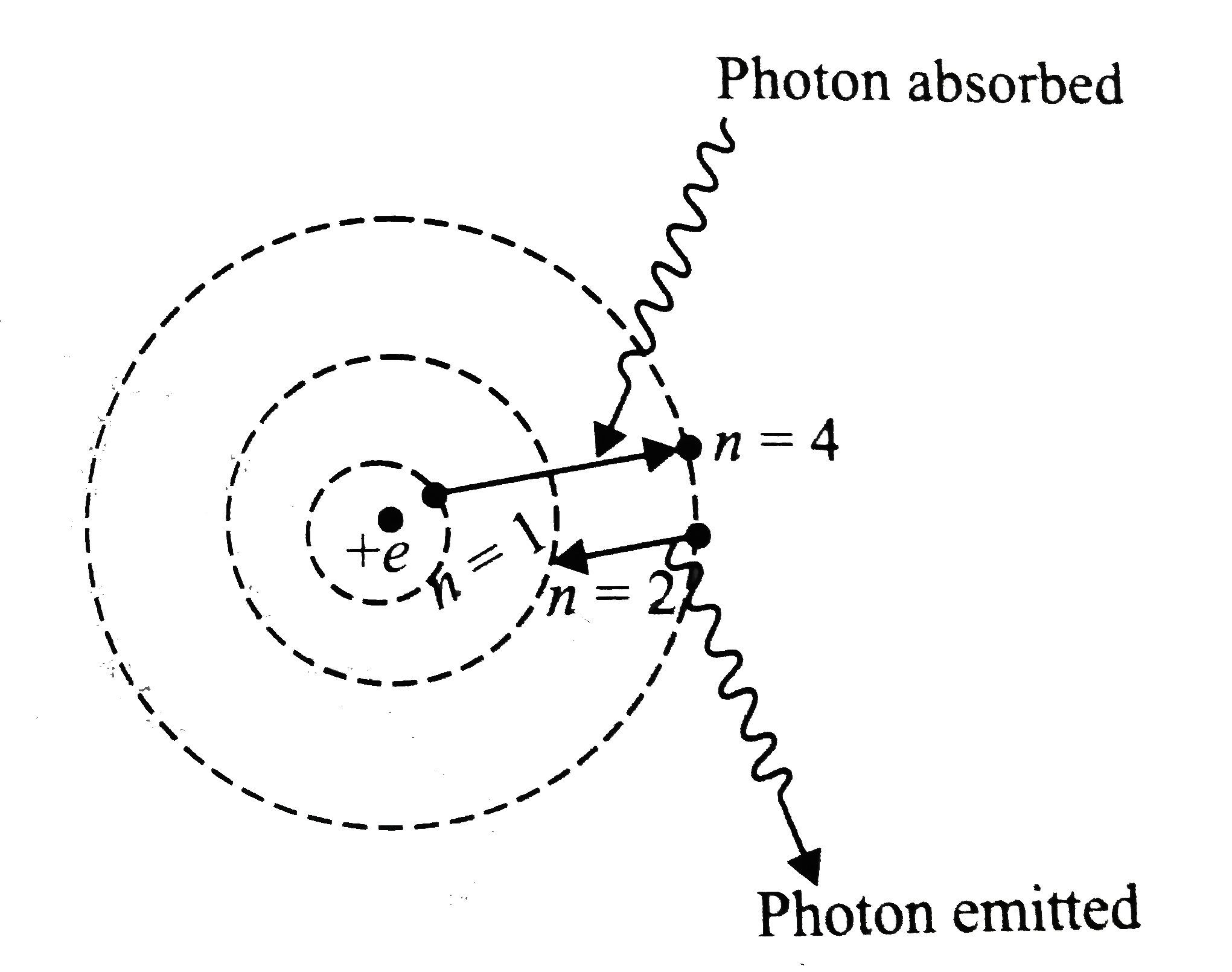A hydrogen atom in the ground state is hit by a photon exctting electron to the thoird excerd state .The electron then drops to the second orbit. What is the frequency of radiation emitted and abserbed in the process ?
Energy is absorbed when the electron moves from the ground state (n=1) to the third excted state (n=4)
First calculate the energy difference between n=1 and n=4

Use ΔE(1→4)=2.18×10−18×Z2×(1n21−1n22)
HereZ=1,n1=1,n2=4
∴ΔE(1→4)=2.18×10−19×12×(112−142)J
=2.04×10−19J
This is the energy of the photon obserbed
Ephoton=hv=1.04×10−19J to get
⇒v=3.08×1015Hz
Similarly , when electron jumps from n=4→n=2 the energy is emitted and is given by the same relation
Putting n1=2 and n2=4 in the expression of ΔE we get
ΔE(4→2)=2.18×10−19×12×(122−142)J
=4.08×10−19J
The is the energy of the photon emitted
Ephoton=hv=4.08×10−19J
⇒v=6.16×1014Hz
Topper's Solved these Questions
- BOOK - CENGAGE CHEMISTRY ENGLISHCHAPTER - ATOMIC STRUCTUREEXERCISE - Exercises (Subjective)52videos
ATOMIC STRUCTURE
- BOOK - CENGAGE CHEMISTRY ENGLISHCHAPTER - ATOMIC STRUCTUREEXERCISE - Exercises Linked Comprehension50videos
ATOMIC STRUCTURE
- BOOK - CENGAGE CHEMISTRY ENGLISHCHAPTER - APPENDIX - INORGANIC VOLUME 1EXERCISE - chapter-7 Single correct answer1videos
APPENDIX - INORGANIC VOLUME 1
- BOOK - CENGAGE CHEMISTRY ENGLISHCHAPTER - CHEMICAL BONDING AND MOLECULAR STRUCTUREEXERCISE - Archives Subjective15videos
CHEMICAL BONDING AND MOLECULAR STRUCTURE
Similar Questions
In a hydrogen atom, the binding energy of the electron in the ground state is E1 then the frequency of revolution of the electron in the nth orbit is
View SolutionA hydrogen like atom in ground st6ate abserbs n photon having the same energy and its emit exacity n photon when electron transition tekes placed .Then the energy of the absorbed photon may be
View Solution
Knowledge Check
- Question 1 - Select One
The wavelength of radiation emitted is λ0 when an electron jumps from the third to the second orbit of hydrogen atom. For the electron jump from the fourth to the second orbit of hydrogen atom, the wavelength of radiation emitted will be
A(16/25)λ0B(20/27)λ0C(27/20)λ0D(25/16)λ0 - Question 2 - Select One
the wavelength of radiation emitted is λ0 when an electron jumps. From the third to second orbit of hydrogen atom. For the electron jumping from the fourth to the second orbit of the hydrogen atom, the wavelength of radiation emitted will be
A(16/25)λ0B(20/27)λ0C(27/20)λ0D(25/16)λ0
The speed of an electron in the orbit of hydrogen atom in the ground state is
View SolutionIf an electron in hydrogen atom jumps from third orbit to second orbit, the frequency of the emitted radiation is given by (c is speed of light )
View Solutionif the electron in hydrogen orbit jumps form third orbit to second orbit, the wavelength of the emitted radiation is given by
View SolutionA hydrogen atom in ground state absorbs 10.2eV of energy .The orbital angular momentum of the electron is increases by
View SolutionThe energy needed to detach the electron of a hydrogen like ion in ground state is a 4 Rydberg. (a) what is the wavelength of the radiation emitted when the electron jumps from the first excited state to the ground state? (b) What is the radius of the orbit for this atom?
View SolutionWhen the electron in hydrogen atom jumps from the second orbit to the first orbit, the wavelength of the radiation emitted is λ. When the electron jumps from the third to the first orbit . The wavelenth of the radiation emitted is
View Solution
